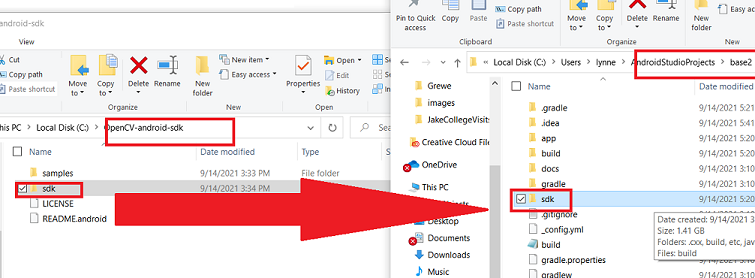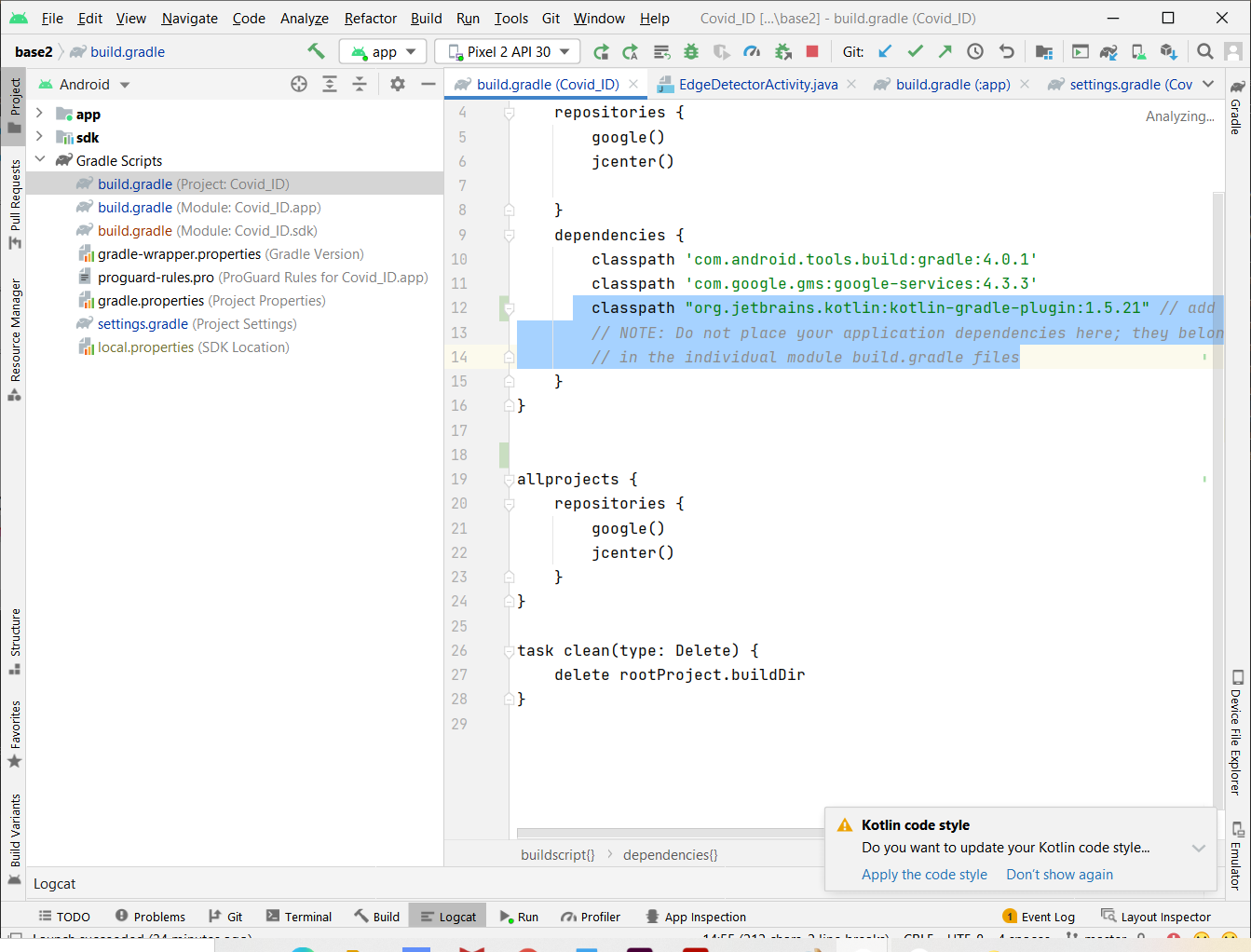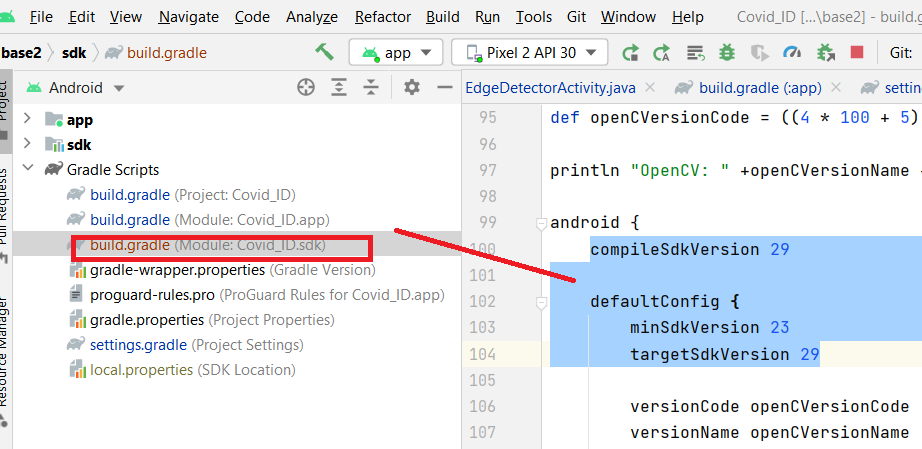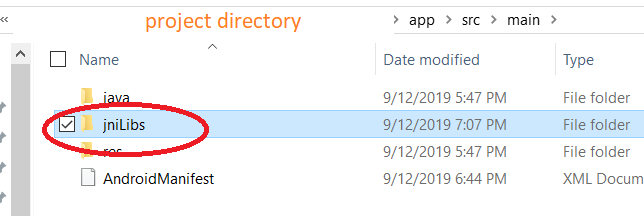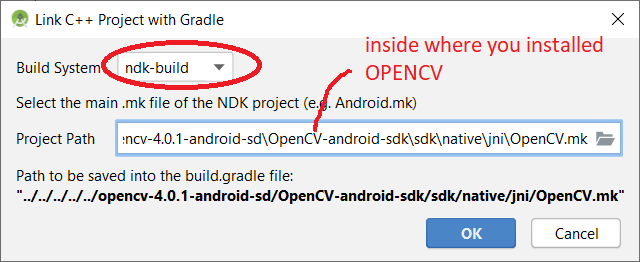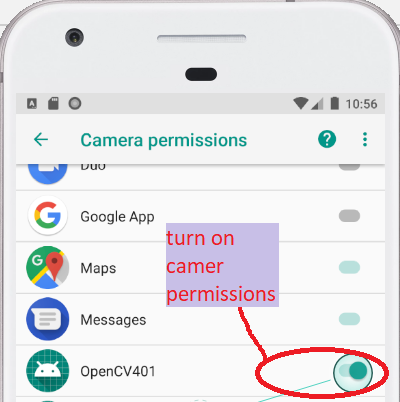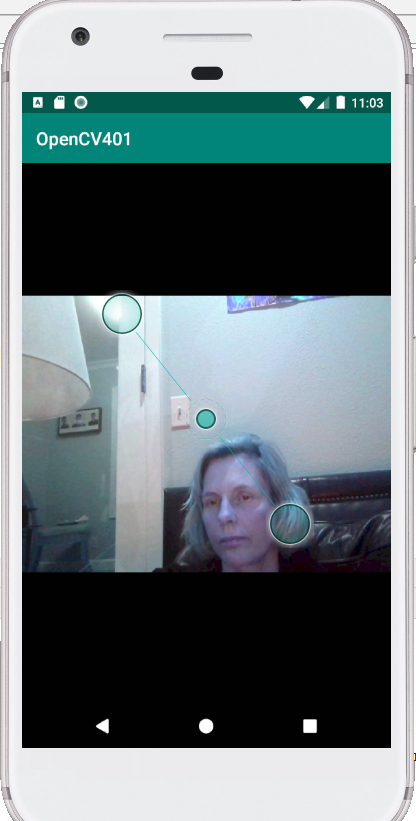How to add OpenCV module and dependency for Android Project AND
create basic OpenCV application (capture and displays image)
****THIS "VERSION" Of how to do this process involves a work around for a known Android Studio bug********
- see : https://stackoverflow.com/questions/68649524/opencv-android-studio-module-importing-issue
- AND https://issuetracker.google.com/issues/199939605
-
CS663 students,
I
STEP 0) create project or open existing project(see example on previous page)
File-> New Project OR do File->New Project from Version Control (and specify github url)
STEP 1) Download the current OpenCV for ANDROID version you wish.
-
remember where you stored it on your local machine
STEP 2) WORK AROUND FOR IMPORT MODULE BUG IN ANDROID STUDIO:
COPY the sdk folder from the OpenCV code in step 1 into your project folder
Here you can see what the project structure will look like after step 2

STEP 3) We need to modify a number of the gradle build and settings files:
STEP 3.1: Edit the settings.gradle file and add include ':sdk' (where sdk is the "name of my OpenCV module I added)
|
STEP 3.2: Edit the project's build.gradle file so that you add the following line under dependenciesclasspath "org.jetbrains.kotlin:kotlin-gradle-plugin:1.5.21"
|
STEP 3.3: edit the app's build.gradle file so it contains under dependenciesimplementation project(':sdk')
|
STEP 3.4: edit the gradel build file for the OPENCV module ....see changes in BLUE... to set compile and min and target sdk's to
|
STEP 4)Sync or do a Project->Clean...try to compile to make sure no errors.
STEP 5) Add Native Libraries to your Project (YOU PROBABLY WILL BE PROMPTED TO DO THIS IN STEP 4--- it will say something like install NDK etc --DO IT)
-
Some files within OpenCV are native. This means they aren’t written in Java but C++.
IF YOU ARE NOT PROMPTED THEN YOU CAN DO THIS MANUALLY:
These files are available within the libs folder.
Copy the libs folder in the native folder over to your project app module main folder (Usually ProjectName/app/src/main).
Rename the libs folder you just copied into your project to jniLibs.
In android file view mode
Right Click on app-> “Link c++ project with gradle”

Now specify a ndk-build AND th make file that is shown below and located inside where you installed the OpenCV software on your system.
PART 2: If code from scratch (not cloned code) ---then continue with following
STEP 6) (ONLY IF NOT ALREADY THERE IN SAY CLONED CODE, BUT WILL NEED FOR NEW PROJECT FROM SCRATCH)
Update your Manifest File to have permissions to use camera
Add the following permission to use camera and using feature tags
<uses-permission android:name="android.permission.CAMERA"/>
<uses-feature android:name="android.hardware.camera" android:required="false"/>
<uses-feature android:name="android.hardware.camera.autofocus" android:required="false"/>
<uses-feature android:name="android.hardware.camera.front" android:required="false"/>
<uses-feature android:name="android.hardware.camera.front.autofocus" android:required="false"/>

STEP 7) Modify the XML layout file to contain a JavaCameraView widget to display the image being captured
(and later you can add code to process it too) by OpenCV framework
<org.opencv.android.JavaCameraView
android:layout_width="fill_parent"
android:layout_height="fill_parent"
app:layout_constraintLeft_toLeftOf="parent"
app:layout_constraintRight_toRightOf="parent"
app:layout_constraintTop_toTopOf="parent"
android:id="@+id/HelloOpenCvView"
/>

STEP 8) Use the following beginning Activity code instead of the default beginning Main Activity project code
(or modify your existing Activity to add the code
in the methods shown below to what you already have).
NOTE: this code is if you are using OpenCV for image capture. If you are using Java api for image capture the code will be different and you will integrate your
OpenCV code in an Activity that does Java api based image capture(see class website or search web for sample for java based image capture Activites)
>>the code in blue below signifies the OpenCV code for loading the OpenCV module and the comments in Green indicate what you would do in a Java api based image capture activity
package com.grewe.ilab.opencv401; //THIS will change and be YOUR package name
import androidx.appcompat.app.AppCompatActivity;
import android.os.Bundle;
import androidx.appcompat.app.AppCompatActivity;
import android.os.Bundle;
import android.util.Log;
import android.view.SurfaceView;
import android.view.WindowManager;
import android.widget.Toast;
import org.opencv.android.OpenCVLoader;
import org.opencv.android.CameraBridgeViewBase;
import org.opencv.core.Mat;
import org.opencv.android.CameraBridgeViewBase.CvCameraViewListener2;
public class MainActivity extends AppCompatActivity implements CvCameraViewListener2 {
// will point to our View widget for our image
private CameraBridgeViewBase mOpenCvCameraView;
private static final String TAG = "OCVSample::Activity";
@Override
protected void onCreate(Bundle savedInstanceState) {
Log.i(TAG, "called onCreate");
super.onCreate(savedInstanceState);
//Load in the OpenCV dependency module code from the jni files you linked in this project
// inside the OpenCV module
if (!OpenCVLoader.initDebug()) {
Toast.makeText(MainActivity.this, "Unable to load OpenCV", Toast.LENGTH_LONG).show();
}
getWindow().addFlags(WindowManager.LayoutParams.FLAG_KEEP_SCREEN_ON);
setContentView(R.layout.activity_main);
// grab a "handle" to the OpenCV class responsible for viewing Image
// look at the XML the id of our CameraBridgeViewBase is HelloOpenCVView
mOpenCvCameraView = (CameraBridgeViewBase) findViewById(R.id.HelloOpenCvView);
//set it visible, register the listener and enbale the view so connected to camera
mOpenCvCameraView.setVisibility(SurfaceView.VISIBLE);
mOpenCvCameraView.setCvCameraViewListener(this); // the activity will listen to events on Camera -call onCameraFrame
mOpenCvCameraView.enableView();
}
// disable JavaCameraView if app going on pause
@Override
public void onPause() {
super.onPause();
if (mOpenCvCameraView != null)
mOpenCvCameraView.disableView();
}
//enable the JavaCameraView if app resuming
@Override
public void onResume() {
super.onResume();
if (mOpenCvCameraView != null)
mOpenCvCameraView.enableView();
}
//Disable view of JavaCameraView if app is being destoryed
@Override
public void onDestroy() {
super.onDestroy();
if (mOpenCvCameraView != null)
mOpenCvCameraView.disableView();
}
//method invoked when camera view is started
public void onCameraViewStarted(int width, int height) {
}
//method invoked when camera view is stoped
public void onCameraViewStopped() {
}
// THIS IS THE main method that is called each time you get a new Frame/Image
// Implement to be a CVCameraViewListener2
public Mat onCameraFrame(CameraBridgeViewBase.CvCameraViewFrame inputFrame) {
//store in the imageMat (instance of OpenCV's Mat class, a 2D matrix) the RGB(A=alpha) image
Mat imageMat = inputFrame.rgba(); /* note in an Java API based capture Activity you will have a method that is invoked when a new frame is digitized and you will need to convert the image frame datastructure object from Java api to an OpenCV Mat object instance so it can be processed with OpenCV calls Typically this means converting a Bitmap to an OpenCV Mat. Mat openCVMatImage = new Mat (bmp.getWidth(), bmp.getHeight(), CvType.CV_8UC1); Utils.bitmapToMat(bmp, openCVMatImage); Then you can process it like the following line that converts an rgb image to greyscale in this call I am storing the results in the same Mat object mgproc.cvtColor(openCVMatImage,openCVMatImage, Imgproc.COLOR_RGB2GRAY); */
//Process Image as desired --note the following is commented out but gives you an idea
// now you use the Mat class to represent the Image and you can use method calls
// like imageMat
// make calls like to get a pixel at i,j imageMat.get
// double pixel[] = new double[3];
// pixel = imageMat.get(20,10); this wil retrieve pixel and column = 20, row =10
// similarly can set a pixel in Mat via imageMat.set(i,j,pixel);
// read API on Mat class for OPenCV
// A VERY USEFUL class to call image processing routines is ImagProc
// This code in comments shows how to do the Sobel Edge Detection on our image in imageMat
/*
Mat gray = inputFrame.gray();
Mat mIntermediateMat = new Mat();
Imgproc.Sobel(gray, mIntermediateMat, CvType.CV_8U, 1, 1);
Core.convertScaleAbs(mIntermediateMat, mIntermediateMat, 10, 0);
Imgproc.cvtColor(mIntermediateMat, imageMat, Imgproc.COLOR_GRAY2BGRA, 4);
*/
//Return the Mat you want to be displayed in the JavaCameraView widget which invoked this method
return imageMat;
}
}
